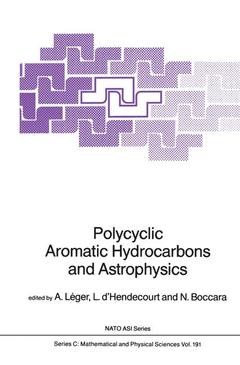Polycyclic Aromatic Hydrocarbons and Astrophysics, 1987 Nato Science Series C: Series, Vol. 191
Langue : Anglais
Coordonnateurs : Léger A., D'Hendecourt L., Boccara N.

The near Infra-Red emission of the Interstellar Medium is a very puzzling subject. In the brightest regions, where spectroscopic observa tions are possible from the ground, several bands (3.3 - 3.4 - 6.2 - 7.7 - 8.6 - 11.3 ~m) have been observed since 1973. The absence of satisfying explanation was so obvious that they were called "Unidenti fied IR Emission Bands". The puzzle still increased when were known the first results of the general IR sky survey made by the satellite IRAS. On a large scale, the near IR emission of the Interstellar medium was expected to be very small but it was observed to be about one third of the total IR emission for our own galaxy ..? The situation has moved in 1984 when it was suggested that a class of stable organic molecules, the Polycyclic Aromatic Hydrocarbons (PAH's) could be at the origin of this near IR emission. Initially based on the required refractory character of particules that should be heated to high temperature without subliming, this hypothesis leads to a sugges tive spectroscopic similarity with the observed astronomical bands. This hypothesis is attractive and it has many implications, for ins tance, the PAHs would be the most abundant organic molecules in the universe. However, many points have to be clarified and the different consequences of this suggestion should be explored.
Section 1: Introduction.- Objectives of the Workshop.- Photons, Molecules and Solids in Interstellar and Circumstellar Regions: an Introduction for Non-Astronomers.- Section 2: Physics and Chemistry of Graphite, Carbonaceous Grains and Clusters.- On the Electronic Structure of Graphite.- Various Kinds of Solid Carbon: Structure and Optical Properties.- Gas/Carbonaceous Surface Interactions.- VUV to FIR Laboratory Observations on Submicron Amorphous Carbon Particles.- Spectroscopy of Matrix-Isolated Carbon Molecules in the UV, VIS, and IR Spectral Range.- Remarkable Periodicities in the Mass Spectra of Carbon Aggregates.- Reactions of Thermal Hydrogen Atoms and Energetic Hydrogen and Oxygen Ions with Pyrolytic Graphite.- Section 3: Physics and Chemistry of Polycyclic Aromatic Hydrocarbons (Pah’s).- Photophysics, Electronic Spectroscopy and Relaxation of Molecular Ions and Radicals with Special Reference to Polycyclic Aromatic Hydrocarbons.- Fluorescence Lineshapes of Polyatomic Molecules — Spectroscopy without Eigenstates.- Structure and Chemistry of PAH’s.- Synthesis and Spectroscopy of Tribenzo(a, g, m)Coronene, a New, Exceptionally Stable, Fully Benzenoid PAH.- Hot Carbon Atoms as a Potential Source for Polycyclic Aromatic Hydrocarbons.- Section 4: Carbonaceous Materials and Astrophysics.- Carbon Components of Interstellar Dust.- Molecular Origin of the 216 nm Interstellar Hump.- Chains and Grains in Interstellar Space.- Mid Infrared Excess and Ultraviolet Extinction.- High Spectral Resolution Observation of the 3.3 ?m Emission Band and Comparison with Laboratory-Synthesized Quenched Carbonaceous Composite (QCC).- DISCUSSION I: Carbon in the Interstellar Medium.- Section 5: Polycyclic Aromatic Hydrocarbons and Astrophysics.- Identification of PAH’s inAstronomical IR Spectra — Implications.- The IR Emission Features: Emission from PAH Molecules and Amorphous Carbon Particles.- The Hydrogen Coverage of Interstellar PAH’s.- New Observations of Infrared Astronomical Bands: IRAS-LRS and 3 ?rn Ground-Based Spectra.- Distribution of PAH in the Galaxy Derived from the IRAS Data.- Infrared Features in Extragalactic Objects.- Very Small Grains in Spiral Galaxies.- IRAS Observations of a “Typical” Dark Cloud.- Coal Tar as a Laboratory Analog of an Interstellar PAH Mixture.- Hydrogenated Amorphous Carbon (a:C-H) in the Planetary Nebula NGC 7027.- Visual and Infrared Fluorescence from L1780.- DISCUSSION II: Interpretation of IR Observations.- Section 6: Diffuse Interstellar Bands.- Possible Carriers of the Diffuse Interstellar Bands.- DISCUSSION III: The Diffuse Interstellar Bands. Are they Carried by PAH’s?.- Section 7: Physics and Chemistry of Pah’s in the Interstellar Medium.- Physics and Chemistry of Interstellar Polycyclic Aromatic Molecules.- Formation, Destruction and Excitation of Carbon Grains and PAH Molecules.- Polyaromatic Hydrocarbons and the Condensation of Carbon in Stellar Winds.
Date de parution : 09-2011
Ouvrage de 402 p.
15.5x23.5 cm
Disponible chez l'éditeur (délai d'approvisionnement : 15 jours).
Prix indicatif 210,99 €
Ajouter au panierMots-clés :
Galaxy; astrophysics; galaxies; interstellar matter; planet; spectroscopy; stellar; universe
© 2024 LAVOISIER S.A.S.



